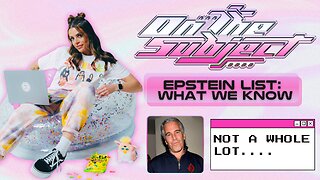Premium Only Content

Part 8 Data access in mvc using entity framework
Tags
asp.net mvc database tutorial
asp.net mvc database application tutorial
creating asp.net mvc application with database
asp.net mvc database connection using entity framework
asp.net mvc database project
database connectivity in asp.net mvc
The controller responds to URL request, gets data from a model and hands it over to the view. The view then renders the data. Model can be entities or business objects.
In part 7, we have built Employee entity.
public class Employee
{
public int EmployeeId { get; set; }
public string Name { get; set; }
public string Gender { get; set; }
public string City { get; set; }
}
In this video, we will discuss, retrieving data from a database table tblEmployee using entity framework. In a later video, we will discuss using business objects as our model.
Step 1: Install entity framework, if you don't have it installed already on your computer. At the time of this recording the latest version is 5.0.0.0. Using nuget package manager, is the easiest way to install. A reference to EntityFramework.dll is automatically added.
Open visual studio - Tools - Library Package Manager - Manage NuGet Packages for Solution
Step 2: Add EmployeeContext.cs class file to the Models folder. Add the following "using" declaration.
using System.Data.Entity;
Copy & paste the following code in EmployeeContext.cs
public class EmployeeContext : DbContext
{
// Replace square brackets, with angular brackets
public DbSet[Employee] Employees {get; set;}
}
EmployeeContext class derives from DbContext class, and is responsible for establishing a connection to the database. So the next step, is to include connection string in web.config file.
Step 3: Add a connection string, to the web.config file, in the root directory.
Step 4: Map "Employee" model class to the database table, tblEmployee using "Table" attribute as shown below.
[Table("tblEmployee")]
public class Employee
{
public int EmployeeId { get; set; }
public string Name { get; set; }
public string Gender { get; set; }
public string City { get; set; }
}
Note: "Table" attribute is present in "System.ComponentModel.DataAnnotations.Schema" namespace.
Step 5: Make the changes to "Details()" action method in "EmployeeController" as shown below.
public ActionResult Details(int id)
{
EmployeeContext employeeContext = new EmployeeContext();
Employee employee = employeeContext.Employees.Single(x =] x.EmployeeId == id);
return View(employee);
}
Step 6: Finally, copy and paste the following code in Application_Start() function, in Global.asax file. Database class is present "in System.Data.Entity" namespace. Existing databases do not need, database initializer so it can be turned off.
Database.SetInitializer[MVCDemo.Models.EmployeeContext](null);
That's it, run the application and notice that the relevant employee details are displayed as expected.
-
 LIVE
LIVE
TimcastIRL
59 minutes agoEPSTEIN Files DROP, FBI GOES ROGUE, AG Says They COVERED UP Epstein Case w/Amber Duke | Timcast IRL
18,857 watching -
 LIVE
LIVE
Kim Iversen
1 hour ago"Canada's Trump" Is Trudeau’s Worst Nightmare: Is Maxime Bernier the Future of Canada?
1,554 watching -
 DVR
DVR
Bannons War Room
10 days agoWarRoom Live
2.58M436 -
 16:06
16:06
The Rubin Report
7 hours agoProof the Islamist Threat in England Can No Longer Be Ignored | Winston Marshall
34.3K22 -
 2:07:07
2:07:07
Robert Gouveia
5 hours agoFBI Files Coverup! Bondi FURIOUS; SCOTUS Stops Judge; Special Counsel; FBI Does
40.5K32 -
 56:15
56:15
Candace Show Podcast
5 hours agoBREAKING: My FIRST Prison Phone Call With Harvey Weinstein | Candace Ep 153
107K69 -
 LIVE
LIVE
megimu32
1 hour agoON THE SUBJECT: The Epstein List & Disney Channel Original Movies Nostalgia!!
195 watching -
 9:06
9:06
Colion Noir
10 hours agoKid With Gun Shoots & Kills 2 Armed Robbers During Home Invasion
16.9K3 -
 54:28
54:28
LFA TV
1 day agoUnjust Man | TRUMPET DAILY 2.27.25 7PM
19.7K2 -
 20:10
20:10
CartierFamily
7 hours agoAndrew Schulz DESTROYS Charlamagne’s WOKE Meltdown on DOGE & Elon Musk!
36.8K45